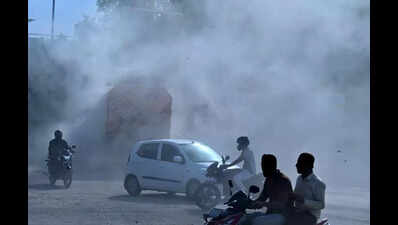Why Hyderabad’s Air Quality Remains Poor Despite Heavy Rains

Heavy Rain Brings Little Relief
Hyderabad experienced heavy rainfall in May. The city received up to 120 mm of rain. However, the air quality remains poor. The rain did little to clean the air.
Pollution Levels Stay High
Data from the Central Pollution Control Board (CPCB) shows high pollution levels throughout the year. Pollutants like PM2.5, PM10, nitrogen dioxide (NO₂), carbon monoxide (CO), and ozone remain high.
- PM10 levels in the Old City were around 150 µg/m³ recently.
- This is ten times higher than the safe limit of 15 µg/m³.
- Last November, PM10 levels even went above 200 µg/m³.
- In July 2024, during peak monsoons, the reading was still high at 148 µg/m³.
Concrete and Heat Make It Worse
Carbon monoxide levels are also high throughout the year. At Somajiguda, the weekly average was 94 µg/m³ last week. This is over 20 times higher than the safe limit of 4 µg/m³.
Babu Rao, an environmental scientist, explains: “Hyderabad is full of concrete and asphalt. These materials absorb and radiate heat. This makes the city hotter and reduces wind flow. Both of these worsen air quality.”
Traffic Emissions Add to the Problem
Traffic emissions are a major issue. Narsimha Reddy Donthi, an environmentalist, points to chronic congestion. “Hyderabad’s traffic rarely flows; it idles,” he says. “Idling engines emit carbon monoxide and fine particulates that build up over time.”
Nearly 80% of the city’s NO₂ emissions come from diesel buses, three-wheelers, and old petrol vehicles. Ground-level ozone forms from chemical reactions. Sunlight and heat react with NO₂ from vehicles and industries to create this harmful gas.
Experts Call for Action
Experts call for a multifaceted response to improve air quality. Rahul Goel, an air quality researcher from IIT Delhi, suggests:
- Improving public transport.
- Encouraging non-motorised transport like cycling and walking.
- Enforcing stricter vehicle and fuel regulations.
- Monitoring industrial waste and construction activity more closely.
Goel adds, “Dust from construction sites is a major contributor to PM pollution. Simple measures, like enclosing sites with curtains and sprinkling water, can reduce airborne particles.”
He stresses that policy alone isn’t enough without enforcement. “We may not be able to eliminate pollution, but we can contain it,” he says.



